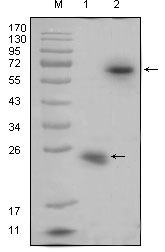R-spondin1 Antibody
Purified Mouse Monoclonal Antibody
- SPECIFICATION
- CITATIONS
- PROTOCOLS
- BACKGROUND

Application
| WB, E |
|---|---|
| Primary Accession | Q2MKA7 |
| Reactivity | Human |
| Host | Mouse |
| Clonality | Monoclonal |
| Clone Names | 7A6 |
| Isotype | IgG1 |
| Calculated MW | 28.9kDa |
| Description | R-spondin1, also known as RSPO1, CRISTIN3, FLJ40906. Entrez Protein NP_001033722.1. It is a member of the R-spondin family and a 28.9kDa secreted activator protein with two cystein-rich, furin-like domains and one thrombospondin type 1 domain. In mice, the protein induces the rapid onset of crypt cell proliferation and increases intestinal epithelial healing, providing a protective effect against chemotherapy-induced adverse effects.It is activator of the beta-catenin signaling cascade, leading to TCF-dependent gene activation. Acts both in the canonical Wnt/beta-catenin-dependent pathway, possibly via a direct interaction with Wnt proteins, and in a Wnt-independent beta catenin pathway through a receptor signaling pathway that may not use frizzled/LRP receptors. Acts as a ligand for frizzled FZD8 and LRP6. May negatively regulate the TGF-beta pathway. Has a essential roles in ovary determination. |
| Immunogen | Purified recombinant fragment of R-spondin1 expressed in E. Coli. |
| Formulation | Ascitic fluid containing 0.03% sodium azide. |
| Gene ID | 284654 |
|---|---|
| Other Names | R-spondin-1, Roof plate-specific spondin-1, hRspo1, RSPO1 |
| Dilution | WB~~1/500 - 1/2000 |
| Storage | Maintain refrigerated at 2-8°C for up to 6 months. For long term storage store at -20°C in small aliquots to prevent freeze-thaw cycles. |
| Precautions | R-spondin1 Antibody is for research use only and not for use in diagnostic or therapeutic procedures. |
| Name | RSPO1 |
|---|---|
| Function | Activator of the canonical Wnt signaling pathway by acting as a ligand for LGR4-6 receptors (PubMed:29769720). Upon binding to LGR4-6 (LGR4, LGR5 or LGR6), LGR4-6 associate with phosphorylated LRP6 and frizzled receptors that are activated by extracellular Wnt receptors, triggering the canonical Wnt signaling pathway to increase expression of target genes. Also regulates the canonical Wnt/beta-catenin- dependent pathway and non-canonical Wnt signaling by acting as an inhibitor of ZNRF3, an important regulator of the Wnt signaling pathway. Acts as a ligand for frizzled FZD8 and LRP6. May negatively regulate the TGF-beta pathway. Has a essential roles in ovary determination. Regulates Wnt signaling by antagonizing DKK1/KREM1- mediated internalization of LRP6 through an interaction with KREM1 (PubMed:17804805). |
| Cellular Location | Secreted. Nucleus {ECO:0000250|UniProtKB:Q9Z132} Note=Seems to mainly localize to nucleoli {ECO:0000250|UniProtKB:Q9Z132} |
| Tissue Location | Abundantly expressed in adrenal glands, ovary, testis, thyroid and trachea but not in bone marrow, spinal cord, stomach, leukocytes colon, small intestine, prostate, thymus and spleen. |

Thousands of laboratories across the world have published research that depended on the performance of antibodies from Abcepta to advance their research. Check out links to articles that cite our products in major peer-reviewed journals, organized by research category.
info@abcepta.com, and receive a free "I Love Antibodies" mug.
Provided below are standard protocols that you may find useful for product applications.
References
1. Nat Genet. 2006 Nov;38(11):1304-9. 2. Hum Mutat. 2008 Feb;29(2):220-6.
If you have used an Abcepta product and would like to share how it has performed, please click on the "Submit Review" button and provide the requested information. Our staff will examine and post your review and contact you if needed.
If you have any additional inquiries please email technical services at tech@abcepta.com.













 Foundational characteristics of cancer include proliferation, angiogenesis, migration, evasion of apoptosis, and cellular immortality. Find key markers for these cellular processes and antibodies to detect them.
Foundational characteristics of cancer include proliferation, angiogenesis, migration, evasion of apoptosis, and cellular immortality. Find key markers for these cellular processes and antibodies to detect them. The SUMOplot™ Analysis Program predicts and scores sumoylation sites in your protein. SUMOylation is a post-translational modification involved in various cellular processes, such as nuclear-cytosolic transport, transcriptional regulation, apoptosis, protein stability, response to stress, and progression through the cell cycle.
The SUMOplot™ Analysis Program predicts and scores sumoylation sites in your protein. SUMOylation is a post-translational modification involved in various cellular processes, such as nuclear-cytosolic transport, transcriptional regulation, apoptosis, protein stability, response to stress, and progression through the cell cycle. The Autophagy Receptor Motif Plotter predicts and scores autophagy receptor binding sites in your protein. Identifying proteins connected to this pathway is critical to understanding the role of autophagy in physiological as well as pathological processes such as development, differentiation, neurodegenerative diseases, stress, infection, and cancer.
The Autophagy Receptor Motif Plotter predicts and scores autophagy receptor binding sites in your protein. Identifying proteins connected to this pathway is critical to understanding the role of autophagy in physiological as well as pathological processes such as development, differentiation, neurodegenerative diseases, stress, infection, and cancer.


